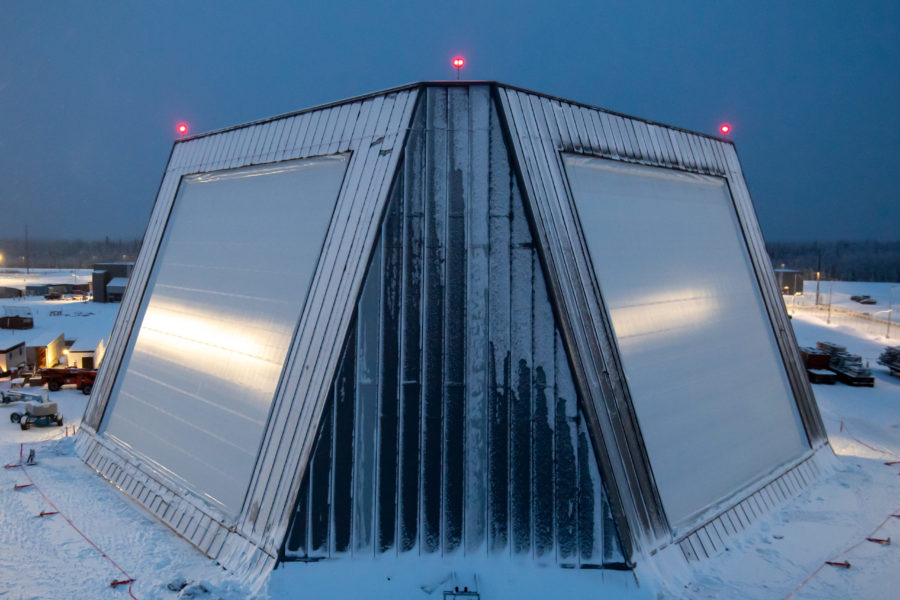Detailed justification for the Space Force’s fiscal 2023 budget request revealed facility expansions for new radar and intercontinental ballistic missile programs and the breakdown of how the service would like to spend $1 billion on missile warning and tracking.
The Department of the Air Force published the detailed “J-book” documents the week of April 18. It is requesting $24.5 billion for the Space Force, an increase of $6.5 billion over the $18 billion enacted by Congress for fiscal 2022. The Space Force’s $24.5 billion makes up 12.6 percent of the Department of the Air Force’s $194 billion request for 2023.
Most of the Space Force’s increase—$4.5 billion—is in research, development, test, and evaluation, including $1 billion in new line items for resilient missile warning and missile tracking.
In its fiscal 2023 budget for military construction, the Space Force would like $68 million to build a three-story, 84-person dormitory at Clear Space Force Station, Alaska, for people who will be assigned there with the new Long Range Discrimination Radar for ballistic missile defense. The remote base, a 77-mile drive from Fairbanks, doesn’t have enough room in its current dorms or in the community, according to the budget documents. The dorm will also require an above-ground passageway connecting it with other parts of the base so Guardians can move around in severe weather.
The service also asked to move ahead with building a “multi-story Consolidated Maintenance Facility” at Vandenberg Space Force Base, Calif., for the forthcoming successor to the Minuteman III intercontinental ballistic missile. The department is requesting $89 million in fiscal 2023 for the facility “to support Ground Based Strategic Deterrent test, launch Operations, and accommodate a crew of 250 personnel.” The department announced earlier in April that it had renamed GBSD the LGM-35A Sentinel. The Sentinel will require all-new “test, support equipment, training and processes,” according to the budget documents.
In line with Secretary of the Air Force Force Frank Kendall’s No. 1 “operational imperative”—to define a “resilient and effective space order of battle and architectures”—the department is requesting $1 billion in new line items for “resilient missile warning missile tracking.” These include money for the Space Development Agency’s already-out-for-bid, low-Earth-orbit “Tracking Layer” of its National Defense Space Architecture; plus the transition of a sensor demonstration experiment to a program of record for another “layer” of missile warning and tracking in medium Earth orbit.
Kendall addressed the items during his speech at the Space Symposium in Colorado Springs in April, saying the new constellations will “be able to track objects like China’s hypersonic weapon systems, or [China’s] potential fractional orbital bombardment system.”
Of the $1 billion for resilient missile warning and missile tracking in fiscal 2023, $499.8 billion is for SDA’s Tracking Layer in low Earth orbit, or LEO.
SDA director Derek Tournear told reporters at the symposium that his office expected to award multiple contracts in June for 28 total satellites—Tranche 1 of the Tracking Layer—to launch in May 2025. Congress gave SDA an extra $550 million in fiscal 2022 to accelerate the Tracking Layer, and SDA officials told reporters in June that they expected Tranche 1 to total $2.5 billion and to be in orbit by 2025. The budget documents show the annual appropriations for the Tracking Layer totaling $3.7 billion through fiscal 2027.
SDA’s “new acquisition model,” described in the budget documents as “utilizing rapid spiral development,” calls for de-orbiting and replacing tranches, or batches, of satellites within the constellation every two years.
The constellation fits into the Space Force’s overall force design for missile warning and tracking. The service’s Space Warfighting Analysis Center recommended a design of 135 of SDA’s LEO satellites and 16 in medium Earth orbit, or MEO, with the two layers “working in concert through an integrated ground solution,” according to the budget documents. “With space assets distributed in multiple orbits, the overall architecture and mission is more resilient in a contested environment.”
Space Systems Command, one of the Space Force’s three field commands, will oversee the development of the MEO layer, which arises from a “prototype effort” the command spearheaded under its previous designation the Space and Missile Systems Center. The service would like $139.1 million in fiscal 2023 and would expect to spend $827.1 million through fiscal 2027.
The budget documents say ground demonstrations of hardware and software took place in fiscal 2022.
“Transitioning development into this program element expands MEO development from a single satellite demonstration into a multiple satellite prototype system that will deliver at least 4 MEO satellites … for a minimum viable product combined warning and tracking architecture” by fiscal 2028.
The final $390.6 million, of the $1 billion for resilient missile warning and tracking in fiscal 2023, is for the LEO and MEO ground systems.
